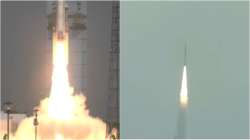ISRO launches new rocket 'SSLV-D2' from Sriharikota
ISRO SSLV D2 launch: The SSLV-D2 soared into the skies at around 9:18 am from the first launch pad at the Satish Dhawan Space Centre and attempt to put three satellites into a 450 km circular orbit during its 15 minute flight, the Indian Space Research Organisation said.

ISRO SSLV D2 launch: The Indian Space Research Organisation (ISRO) undertook the second developmental flight of 'Small Satellite Launch Vehicle' (SSLV) today (February 10) from Sriharikota in Andhra Pradesh.
The information was announced by the space agency on Wednesday (February 8).
The SSLV-D2 soared into the skies at around 9:18 am on Friday from the first launch pad at the Satish Dhawan Space Centre and attempt to put three satellites into a 450 km circular orbit during its 15-minute flight, the Indian Space Research Organisation (ISRO) said.
The three satellites are ISRO's EOS-07, US-based firm Antaris' Janus-1 and Chennai-based space start up SpaceKidz's AzaadiSAT-2. The first test flight of SSLV had ended in partial failure on August 9, as the rocket failed to inject its satellite payload in their intended orbits.
Know about SSLV D2:
SSLV caters to the launch of up to 500 kg satellites to low earth orbits on 'launch-on-demand' basis. It provides low-cost access to space, offers low turn-around time and flexibility in accommodating multiple satellites, and demands minimal launch infrastructure. It is configured with three solid propulsion stages and a velocity terminal module. It is a 34 m tall, 2 m diameter vehicle having a lift-off mass of 120 tonnes.
Know about EOS-07:
EOS-07 is a 156.3 kg satellite which has been designed, developed and realised by ISRO. New experiments include mm-Wave Humidity Sounder and Spectrum Monitoring Payload.
Know about Janus-1:
While, Janus-1, a 10.2 kg satellite, belongs to Antaris, USA.A 8.7 kg satellite, AzaadiSAT-2, is a combined effort of about 750 girl students across India guided by Space Kidz India, Chennai.
ALSO READ: ISRO-NASA built 'NISAR' satellite ready to be shipped to India for launch | DETAILS
An investigation into the failure of SSLV-D1 by ISRO revealed that the mission failed after the upper stage of the launch vehicle injected the satellite into a highly elliptical unstable orbit due to a shortfall in velocity.
It also revealed that there was a vibration disturbance for a short duration on the Equipment Bay (EB) deck during the second stage separation. The vibration affected the Inertial Navigation System (INS), resulting in declaring the sensors faulty by the logic in the Fault Detection and Isolation (FDI) software.
The failure detection logic identified a degraded accelerometer and isolated it for improved mission performance. During the second stage separation, all six accelerometers experienced measurement saturation due to high vibration levels for a short duration. This malfunction initiated a salvage mode with the purpose of saving the mission, but it could not inject the satellite into a safe orbit.
(With agencies inputs)
ALSO READ: Joshimath crisis: NDMA directs ISRO, govt agencies to avoid 'media' interactions without approval

